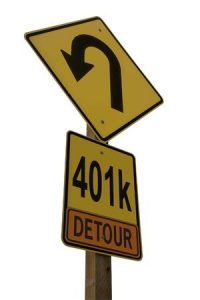 More than a few employers have a bad 401(k) plan. Even if the company is generally a good place to work, it’s a fact of life that the retirement plan isn’t always a top priority for management. Some employers actually have excellent 401(k) plans, but it’s probably closer to the truth that the majority have nothing better than a “me too plan” that exists primarily for the purpose of being just like everybody else in their industry.
More than a few employers have a bad 401(k) plan. Even if the company is generally a good place to work, it’s a fact of life that the retirement plan isn’t always a top priority for management. Some employers actually have excellent 401(k) plans, but it’s probably closer to the truth that the majority have nothing better than a “me too plan” that exists primarily for the purpose of being just like everybody else in their industry.
Since a 401(k) plan is the primary capital accumulation method used by most workers, having a good one is more than just a little bit important.
It’s financially critical for your retirement!
What’s a good 401(k) plan?
- It’s largely self-directed
- Has low fees
- Has more investment options than you’ll ever need
- Allows you to contribute more than some minimal flat amount, like 10% of your pay
- It’s accompanied by an employer match that equals the least 3% of your pay
If your plan is missing any of the above elements, you may have a bad 401(k) plan. If that’s the case, what can you do about it?
Start a self-directed IRA
[adsenseRight]
Generally speaking, contribution limits to an IRA are much lower than it is for a 401(k) program. However, if you have a bad 401(k) plan, also having a self-directed IRA is one of the very best strategies you can have.
Since you have complete control over your IRA, you can select a broker trustee that has the widest possible investment choices, in combination with the lowest possible fees.
Even though your IRA is much smaller than your 401(k) plan, it can provide you with the kind of investment flexibility that your 401(k) plan does not. You can load up your 401(k) plan with lower risk investments that you don’t trade often (to save on transaction costs), then use your self-directed IRA to invest in assets that are not available in your employer plan.
Even if your IRA contributions are not tax deductible due to the combination of having an employer plan and an income that is over the allowable limits, you can still take a non-deductible IRA. And you should – the investment earnings will still be tax-deferred, and the flexibility that an IRA offers can go a long way toward minimizing the damage done by a bad 401(k) plan.
Invest outside of retirement plans
Because of tax deductible contributions and tax deferral of earnings, many people maintain their investments primarily in tax-sheltered retirement plans. But if you have a bad 401(k) plan, you should certainly consider increasing your investments outside the plan.
Non-retirement investments are completely within your control, so they can offset the lack of flexibility in your employer plan. In addition, the fact that non-retirement investments are not tax-sheltered means that you will have assets to draw on in retirement that will not be subject to income taxes. Think of it as a form of retirement tax-diversification.
Start a side business and add a Solo – 401(k)
If you have a side business, or a good idea for starting one, you can add your own retirement plan to the business. A Solo 401(k) plan offers most of the same advantages of an employer-sponsored 401(k). Best of all, you can make dollar for dollar contributions on your side business income up to the 401(k) contribution limit of $17,500 ($23,000 if you’re 50 or older).
Since you are also your own employer, you can also make employer contributions of 25% of your income, over and above your “employee” contribution, up to a combined maximum of $52,000. This is also the combined maximum for all retirement plans, including your employer plan and IRA if you have one.
Make your concerns known to your employer
You can also try to do your best to improve your employer’s 401(k) plan by going through the proper channels. Find out who is responsible for your employer plan, and make your concerns known.
It will help tremendously if you have some sort of written documentation showing that the company’s direct competitors have much more attractive plans, that will give them the upper hand in recruiting the best talent available. That might get your employer’s attention.
But once again, be aware that improving the company’s 401(k) plan is unlikely to be a management priority. There may not even be a person employed by your company who has either the responsibility or the authority to make that happen. What’s more, it is entirely possible that your employer has absolutely no interest in improving the plan whatsoever. After all, that’s probably why it’s a bad plan in the first place.
Still, nothing ventured, nothing gained. If the company will do absolutely nothing to improve the 401(k) plan, you still have the other options above. Be ready to use one or more of them if that turns out to be the case.
Ultimately, you are responsible for your own retirement, and if your employer won’t cooperate you may have to make other plans.
For other ways to grow your retirement savings whether self employed or not check out these articles.
Meet The Government Sponsored Retirement Account-MyRA
7 Ways to Save For Retirement on a Tight Budget
The Minimalist Guide to Retirement Planning for Solopreneurs

James Hendrickson is an internet entrepreneur, blogging junky, hunter and personal finance geek. When he’s not lurking in coffee shops in Portland, Oregon, you’ll find him in the Pacific Northwest’s great outdoors. James has a masters degree in Sociology from the University of Maryland at College Park and a Bachelors degree on Sociology from Earlham College. He loves individual stocks, bonds and precious metals.

